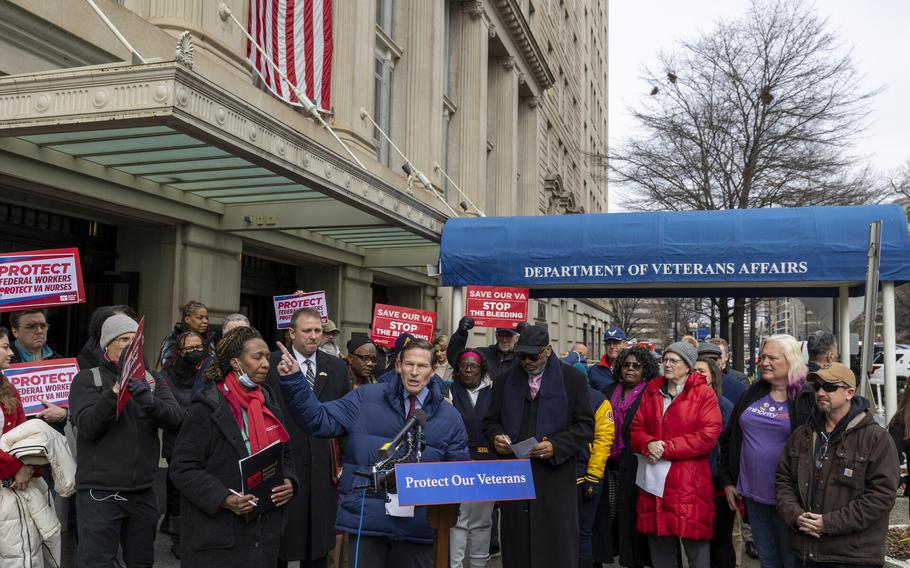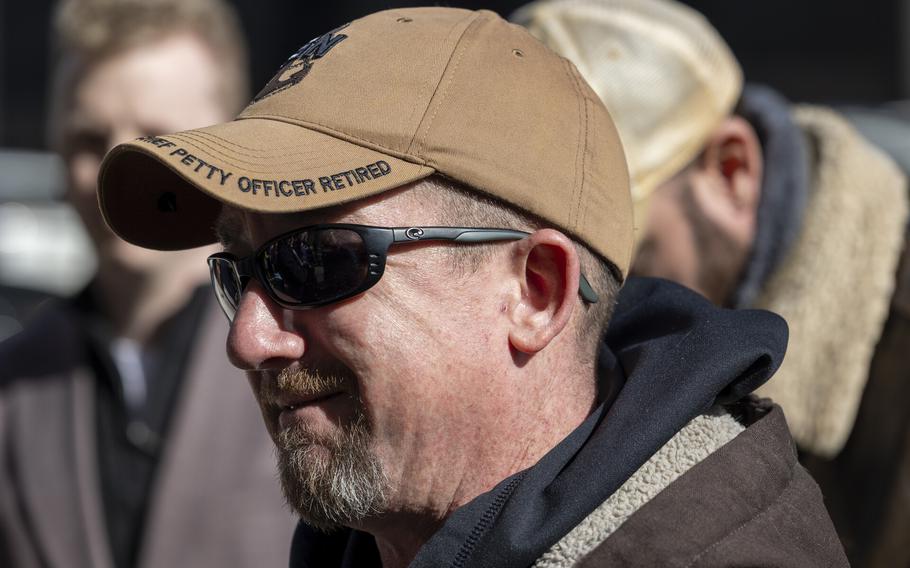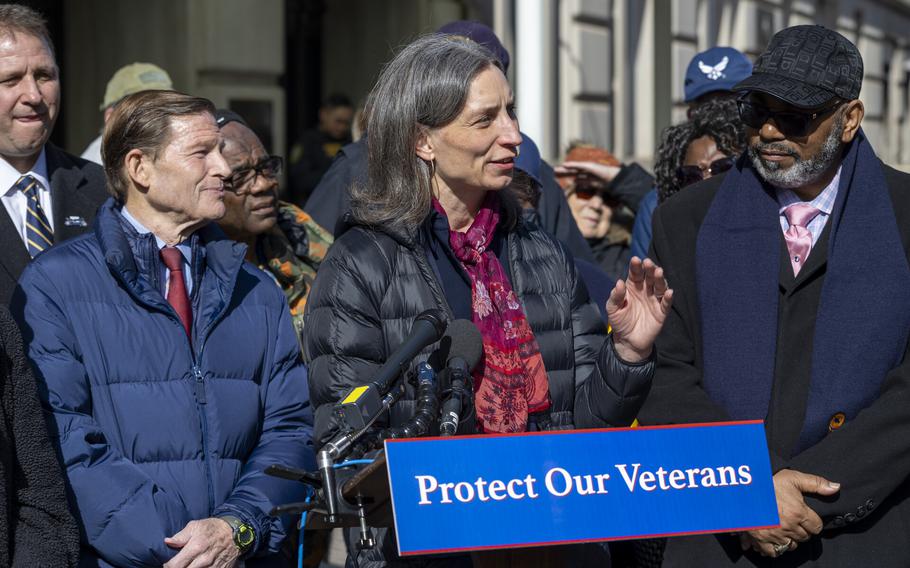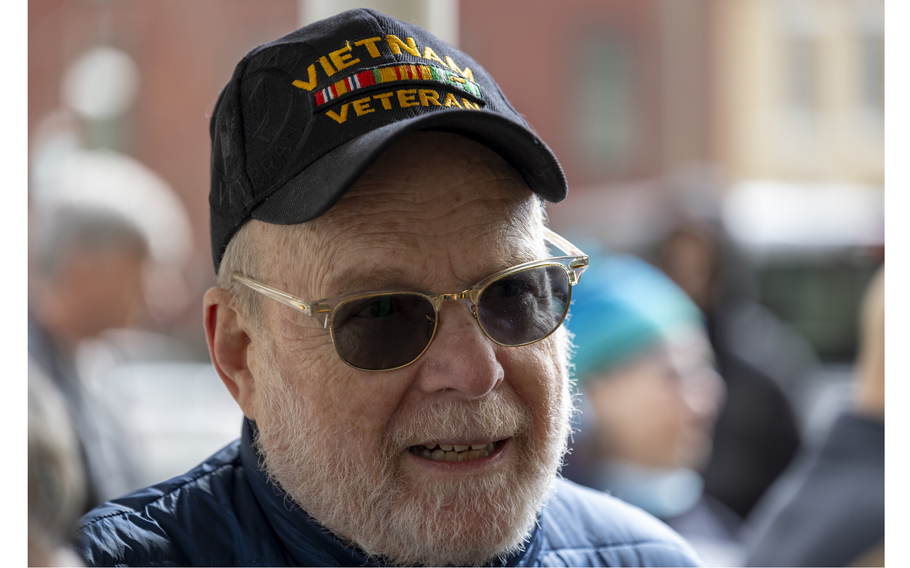
Sen. Richard Blumenthal, D-Conn., speaks Thursday, Feb. 13, 2025, during a news conference outside of the Department of Veterans Affairs headquarters in Washington. (Eric Kayne/Stars and Stripes)
WASHINGTON — Navy veteran Buzz Grambo, who is 100% disabled, took a train from his Baltimore home to the nation’s capital Thursday to rally outside the Department of Veterans Affairs against large-scale cuts planned for the agency’s workforce.
“My big concern is losing my VA health care and benefits,” said Grambo, a 43-year-old retired chief petty officer who suffered a traumatic brain injury during military service. “I get most of my medical care at the VA. Look, for me to travel this far with my disability is an effort. I’m worried.”
Grambo joined other veterans, along with lawmakers and union leaders, to protest a hiring freeze at the VA that is part of a broader effort by President Donald Trump’s administration to reduce the federal workforce. An executive order that Trump signed Tuesday will limit the VA and many other federal agencies to hiring just one new worker for every four who end employment with the government.

Navy veteran Buzz Grambo, 43, of Baltimore attends a rally on Thursday, Feb. 13, 2025, outside of the Department of Veterans Affairs headquarters in Washington. (Eric Kayne/Stars and Stripes)
Trump said the order will restore accountability and eliminate “waste, bloat and insularity” by the federal bureaucracy.
But Sen. Richard Blumenthal, D-Conn., who led the two-hour rally at VA headquarters, predicted a large-scale reduction of the VA workforce will harm veterans services.
“Filling only one out of every four positions would be devastating for the VA and the services it provides to our veterans,” said Blumenthal, who was among several Democratic lawmakers who spoke at the protest.
“When you come after the VA, you come after veterans,” said Rep. Mark Takano, D-Calif. “Some politicians who never miss a photo opportunity with veterans are trying to destroy the very system they rely on.”
Both lawmakers serve on their chamber’s Veterans Affairs committee.
Blumenthal said he is hearing from rank-and-file VA workers who claim the agency is not filling critical vacancies for doctors, nurses and medical technicians, an assertion the VA denied.
Peter Kasperowicz, the VA press secretary, slammed Democratic lawmakers after the rally, blaming organizers for creating unnecessary anxiety among the 9 million veterans who rely on VA services.
“Instead of responding to publicity stunts and fear mongering, VA would prefer to work collaboratively with Congress and other stakeholders to make the department more efficient and responsive to veterans,” he said.
An executive order that Trump signed in January imposed a hiring freeze on federal workers but exempted more than 300,000 positions at the VA deemed essential to veterans health care and department operations, Kasperowicz said.
The hiring freeze targets positions not directly related to the delivery of health care. Exempted positions include addiction therapists, mental health counselors, doctors, nurses, occupational therapists, and pharmacists, among others.
For additional flexibility, VA leaders can request more exceptions to the hiring freeze, Kasperowicz said.
But lawmakers and union leaders representing federal workers who spoke at the rally said more than 25% of the VA workforce is composed of veterans, who will be disproportionately affected by a staff reduction.
A VA staff reduction also will affect the processing of veterans’ claims for benefits, they said.
The VA countered that Trump specifically excluded reducing staff who administer Social Security, Medicare and veterans benefits.
“In addition, the director of the Office of Personnel Management may grant exemptions from this freeze where those exemptions are otherwise necessary,” the executive order states.
VA hospitals and clinics across the nation already struggle to fill vacancies for medical personnel. An aging workforce and retirements contribute to a shortage of physicians affecting the health care industry, according to the American Association of Medical Colleges, which predicts a shortage of 122,000 physicians by 2032.
Rep. Maxine Dexter, D-Ore., who is a physician, spoke at the rally about her experience as chief medical resident at the Denver VA hospital, where she treated veterans in critical care for acute lung injuries from exposure to burn pits.

Rep. Maxine Dexter, D-Ore., speaks Thursday, Feb. 13, 2025, during a rally to save jobs at the Department of Veterans Affairs outside of the agency’s headquarters in Washington. (Eric Kayne/Stars and Stripes)
She mentioned the specialty care received by combat-wounded amputees and veterans experiencing chronic obstructive pulmonary disease, a breathing problem caused by airborne pollutants that damage and scar the lungs.
Dexter said VA hospitals and clinics provide a level of specialized care for veterans’ complex medical needs that they cannot get elsewhere.
“It is antithetical to being an American not to support our veterans and the care they receive at the VA,” she said.
Army veteran Bruce Waxman, 82, who is former president of the Vietnam Veterans of America for northern Virginia, said his organization gets a lot of requests for assistance from former service members who served in the Vietnam War and other conflicts.
“I am very concerned about these veterans not getting the care they earned from their service in the military,” he said.
Waxman, who has served as a peer mentor to fellow veterans, said he has seen firsthand how former service members with addiction problems value and benefit from the substance abuse treatment the VA provides.
“The focus should not be on cutting the staff who provide services like this but on making the VA better,” he said.

Vietnam veteran Bruce Waxman, 82, attends a rally against cutting jobs at the Department of Veterans Affairs outside the agency’s headquarters in Washington on Thursday, Feb. 13, 2025. (Eric Kayne/Stars and Stripes)